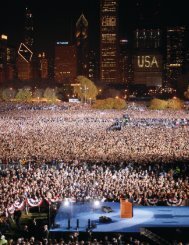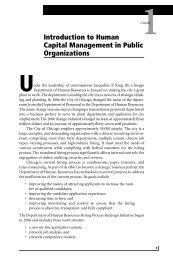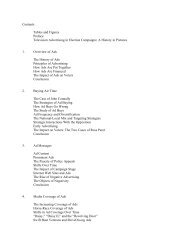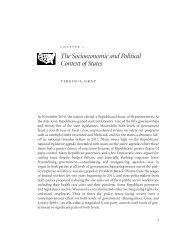Use dialogue as a form of action. - CQ Press
Use dialogue as a form of action. - CQ Press
Use dialogue as a form of action. - CQ Press
- TAGS
- dialogue
- www.cqpress.com
You also want an ePaper? Increase the reach of your titles
YUMPU automatically turns print PDFs into web optimized ePapers that Google loves.
Tool 26<br />
�<br />
<strong>Use</strong> <strong>dialogue</strong> <strong>as</strong> a <strong>form</strong> <strong>of</strong> <strong>action</strong>.<br />
Dialogue advances narrative; quotes delay it.<br />
Novelist Elmore Leonard advised writers “to leave out the part<br />
that readers tend to skip” and to focus on what they read. But<br />
which part is that? He condemns:<br />
Thick paragraphs <strong>of</strong> prose you can see have too many words in<br />
them. What the writer is doing, he’s writing, perpetrating hooptedoodle,<br />
perhaps taking another shot at the weather, or h<strong>as</strong> gone<br />
into the character’s head, and the reader either knows what the<br />
guy’s thinking or doesn’t care. I’ll bet you don’t skip <strong>dialogue</strong>.<br />
(from the New York Times)<br />
Leonard must have my reading habits in mind, the thousand<br />
times I’ve looked down a gray pillar <strong>of</strong> text to find the airy white<br />
space that ventilates <strong>dialogue</strong>. Human speech, captured <strong>as</strong> <strong>dialogue</strong><br />
on the page, attracts the eyes <strong>of</strong> the reader and, if done well,<br />
advances the story.<br />
Consider this scene from Michael Chabon’s novel The Amazing<br />
Adventures <strong>of</strong> Kavalier & Clay:<br />
She turned now and looked at her nephew. “You want to draw<br />
comic books?” she <strong>as</strong>ked him.<br />
128<br />
Copyright © 2008 by <strong>CQ</strong> <strong>Press</strong>, a division <strong>of</strong> Congressional Quarterly Inc. No part <strong>of</strong> these<br />
pages may be quoted, reproduced, or transmitted in any <strong>form</strong> or by any means, electronic<br />
or mechanical, without permission in writing from the publisher.”
Blueprints | 129<br />
Joe stood there, head down, a shoulder against the door frame.<br />
While Sammy and Ethel argued, he had been affecting to study in<br />
polite embarr<strong>as</strong>sment the low-pile, mustard-brown carpeting,<br />
but now he looked up, and it w<strong>as</strong> Sammy’s turn to feel embarr<strong>as</strong>sed.<br />
His cousin looked him up and down, with an expression<br />
that w<strong>as</strong> both appraising and admonitory.<br />
“Yes, Aunt,” he said. “I do. Only I have one question. What is a<br />
comic book?”<br />
Sammy reached into his portfolio, pulled out a cre<strong>as</strong>ed, wellthumbed<br />
copy <strong>of</strong> the latest issue <strong>of</strong> Action Comics, and handed it<br />
to his cousin.<br />
In many ways <strong>dialogue</strong> defines a story because its power drags us<br />
to the scene and sets our ears to the <strong>action</strong>.<br />
Reporters capture human speech with a purpose different<br />
from novelists. They use speech on the page not <strong>as</strong> <strong>action</strong> but <strong>as</strong><br />
an <strong>action</strong> stopper, a place in the text where characters comment<br />
on what h<strong>as</strong> happened. This technique h<strong>as</strong> different names in<br />
different media. In print an effective bit <strong>of</strong> human speech is<br />
called a quote. Television reporters tag it a sound bite. Radio folks<br />
struggle under the awkward word actuality — because someone<br />
actually said it.<br />
The St. Paul Pioneer <strong>Press</strong> covered the sad story <strong>of</strong> Cynthia<br />
Schott, a thirty-one-year-old television anchor who w<strong>as</strong>ted away<br />
and died from an eating disorder.<br />
“I w<strong>as</strong> there. I know how it happened,” says Kathy Bissen, a friend<br />
<strong>of</strong> Schott’s from the TV station. “Everybody did what they individually<br />
thought w<strong>as</strong> best. And together, we covered the spectrum<br />
<strong>of</strong> possibilities <strong>of</strong> how to interact with someone you know h<strong>as</strong> an<br />
illness. And yet, none <strong>of</strong> it made a difference. And you just think<br />
to yourself,‘How can this happen?’ ”<br />
The writer follows advice <strong>of</strong>ten given to new reporters: get a good<br />
quote high in the story. A good quote <strong>of</strong>fers these benefits:<br />
Copyright © 2008 by <strong>CQ</strong> <strong>Press</strong>, a division <strong>of</strong> Congressional Quarterly Inc. No part <strong>of</strong> these<br />
pages may be quoted, reproduced, or transmitted in any <strong>form</strong> or by any means, electronic<br />
or mechanical, without permission in writing from the publisher.”
130 | Writing Tools<br />
• It introduces a human voice.<br />
• It explains something important about the subject.<br />
• It frames a problem or dilemma.<br />
• It adds in<strong>form</strong>ation.<br />
• It reveals the character or personality <strong>of</strong> the speaker.<br />
• It introduces what is next to come.<br />
But quotes also contain a serious weakness. Consider this<br />
quote from a page one story in the New York Times: “Less than<br />
two percentage points we can handle just by not eating out <strong>as</strong><br />
much.”This quote comes from a woman named Joyce Diffenderfer<br />
on how her family copes with mounting credit card debt. But<br />
where is Joyce Diffenderfer when she speaks these words? In her<br />
kitchen? At the desk where she pays her bills? In her workplace?<br />
Most quotes — <strong>as</strong> opposed to <strong>dialogue</strong> — are dis-placed. The<br />
words are spoken above or outside the <strong>action</strong>. Quotes are about<br />
the <strong>action</strong>, not in the <strong>action</strong>. That’s why quotes interrupt the<br />
progress <strong>of</strong> the narrative.<br />
Which returns us to the power <strong>of</strong> <strong>dialogue</strong>. While quotes<br />
provide in<strong>form</strong>ation or explanation, <strong>dialogue</strong> thickens the plot.<br />
The quote may be heard, but <strong>dialogue</strong> is overheard. The writer<br />
who uses <strong>dialogue</strong> transports us to a place and time where we get<br />
to experience the events described in the story.<br />
Journalists use <strong>dialogue</strong> infrequently, so the effect stands out<br />
like a palm tree in a meadow. Consider this p<strong>as</strong>sage by Pulitzer<br />
Prize–winning reporter Thom<strong>as</strong> French on the trial <strong>of</strong> a Florida<br />
firefighter accused <strong>of</strong> a horrible crime against his neighbor:<br />
His lawyer called out his name. He stood up, put his hand on a<br />
Bible and swore to tell the truth and nothing but. He sat down in<br />
the witness box and looked toward the jurors so they could see his<br />
face and study it and decide for themselves what kind <strong>of</strong> man<br />
he w<strong>as</strong>.<br />
“Did you rape Karen Gregory?” <strong>as</strong>ked his lawyer.<br />
Copyright © 2008 by <strong>CQ</strong> <strong>Press</strong>, a division <strong>of</strong> Congressional Quarterly Inc. No part <strong>of</strong> these<br />
pages may be quoted, reproduced, or transmitted in any <strong>form</strong> or by any means, electronic<br />
or mechanical, without permission in writing from the publisher.”
“No sir, I did not.”<br />
Blueprints | 131<br />
“Did you murder Karen Gregory?”<br />
“No sir.” (from the St. Petersburg Times)<br />
The inhibitions against <strong>dialogue</strong> in nonfiction are unfounded.<br />
Although <strong>dialogue</strong> can be recovered and reconstructed<br />
from careful research, using multiple sources and appropriate attribution,<br />
it can also be overheard. An angry exchange between<br />
the mayor and a city council member can be recorded and published.<br />
The writer who did not witness testimony from a trial can<br />
recover accurate <strong>dialogue</strong> from court transcripts, <strong>of</strong>ten available<br />
<strong>as</strong> public records.<br />
The skillful writer can use both <strong>dialogue</strong> and quotes to create<br />
different effects in the same story, <strong>as</strong> in this example from the<br />
Philadelphia Inquirer:<br />
“It looked like two planes were fighting, Mom,”Mark Kessler, 6, <strong>of</strong><br />
Wynnewood, told his mother, Gail, after she raced to the school.<br />
The boy had just witnessed the midair collision <strong>of</strong> a plane and a<br />
helicopter, an accident that dropped deadly wreckage atop an elementary<br />
school playground.We’ve already seen another p<strong>as</strong>sage<br />
from the same story:<br />
“It w<strong>as</strong> one horrible thing to watch,” said Helen Amadio, who w<strong>as</strong><br />
walking near her Hampden Avenue home when the cr<strong>as</strong>h occurred.“It<br />
exploded like a bomb. Black smoke just poured.”<br />
Helen Amadio <strong>of</strong>fers us a true quote, spoken directly to the reporter.<br />
Notice the difference between that quote and the implied<br />
<strong>dialogue</strong> between the young boy and his mother. The six-yearold<br />
describes the scene to his frantic mom. In other words, the <strong>dialogue</strong><br />
puts us on the scene where we can overhear the characters<br />
in <strong>action</strong>.<br />
Copyright © 2008 by <strong>CQ</strong> <strong>Press</strong>, a division <strong>of</strong> Congressional Quarterly Inc. No part <strong>of</strong> these<br />
pages may be quoted, reproduced, or transmitted in any <strong>form</strong> or by any means, electronic<br />
or mechanical, without permission in writing from the publisher.”
132 | Writing Tools<br />
On rare occ<strong>as</strong>ions, the reporter combines the in<strong>form</strong>ation<br />
<strong>of</strong> the quote and the emotional power <strong>of</strong> <strong>dialogue</strong>, but only<br />
when the source speaks in the immediate aftermath <strong>of</strong> the event,<br />
and only when the reporter focuses on both words and <strong>action</strong>s.<br />
Rick Bragg carries this <strong>of</strong>f in his story on the Oklahoma City<br />
bombing:<br />
“I just took part in a surgery where a little boy had part <strong>of</strong> his<br />
brain hanging out <strong>of</strong> his head,”said Terry Jones, a medical technician,<br />
<strong>as</strong> he searched in his pocket for a cigarette. Behind him, firefighters<br />
picked carefully through the skeleton <strong>of</strong> the building, still<br />
searching for the living and the dead.<br />
“You tell me,” he said, “how can anyone have so little respect for<br />
human life.” (from the New York Times)<br />
Leave out the parts readers tend to skip; make room for the parts<br />
they can’t resist.<br />
WORKSHOP<br />
1. Read the newspaper for quotes and fiction for <strong>dialogue</strong>.<br />
Think about their different effects on the reader.<br />
2. Look for missed opportunities to use <strong>dialogue</strong> in nonfiction.<br />
Pay special attention to reports about crime, civic controversies,<br />
and the courtroom.<br />
3. Develop your ear for <strong>dialogue</strong>. With a notebook in hand,<br />
sit in a public space, such <strong>as</strong> a mall or an airport lounge. Eavesdrop<br />
on nearby conversations and jot down some notes on what<br />
it would take to capture that speech in a story.<br />
4. Read the work <strong>of</strong> a contemporary playwright, such <strong>as</strong><br />
Tony Kushner. Read the <strong>dialogue</strong> aloud with friends, and discuss<br />
to what extent it sounds like real speech or seems artificial.<br />
5. Interview two people about an important conversation<br />
they had years ago. Try to re-create the <strong>dialogue</strong> to their satisf<strong>action</strong>.<br />
Speak to them separately, then bring them together.<br />
Copyright © 2008 by <strong>CQ</strong> <strong>Press</strong>, a division <strong>of</strong> Congressional Quarterly Inc. No part <strong>of</strong> these<br />
pages may be quoted, reproduced, or transmitted in any <strong>form</strong> or by any means, electronic<br />
or mechanical, without permission in writing from the publisher.”









